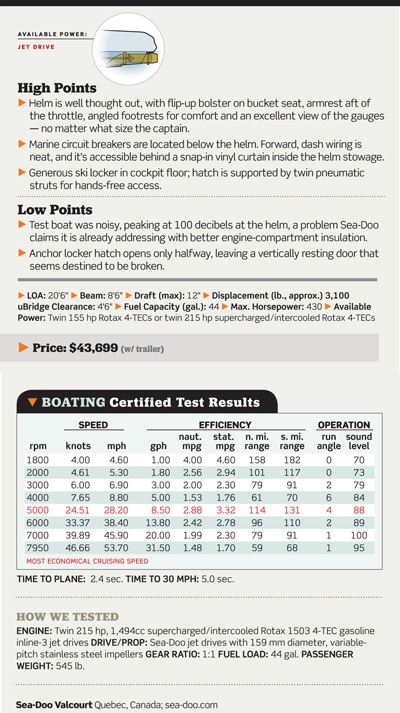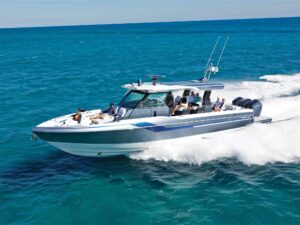Most 21-foot bowriders sacrifice considerable cockpit space. The reason? It’s the engine, and the typically massive sun-pad enclosure that contains it. Sea-Doo’s 210 Challenger SE uses twin, low-profile jet drives, allowing much of that cockpit space to be reclaimed. Mix some mainstream bowrider attributes with unique takes on both the swim platform area and electronic throttle control, and you’ve got a jet that is far removed from the water pistols of the past — and a legitimate contender in this popular size range.
The Challenger is Sea-Doo’s first entry into the 21-foot arena. It’s stylish, features quality construction and looks right at home alongside the Sea Rays and Chaparrals of the world. Step aboard, however, and the subtle differences appear. Sea-Doo takes full advantage of its compact Rotax engines, as well as a jet drive’s ultralow, inline profile. Rather than a bulky engine box impeding space, occupants find a roomy interior, 7 feet by 6 feet 3 inches, flanked by dual captain’s chairs forward and a wraparound, U-shaped bench aft. A walk-through transom splits the bench evenly down the middle. Each side incorporates a small sun pad designed to overhang the swim platform rather than using a giant base. Parents can sit here when the boat isn’t under way and watch the kids in the water. It’s also a convenient spot for skiers and boarders to sit while gearing up. Add a relatively standard bow cockpit and you’ve got room for 10, two more than on Sea Ray’s 210 Select ($49,277 with a 300 hp MerCruiser 350 MAG MPi Alpha stern-drive) and one more than on Yamaha’s 212SS ($38,299 with twin 1,052cc Yamaha High Output jet drives).
The party continues aft. Like Yamaha before it, Sea-Doo realizes people spend considerable time at the beach and on the hook. Pull up the trailing edge of those twin sun pads and you’ll find a hinged, two-piece, molded plastic seat below. Sea-Doo calls them “transat” seats, a french word that loosely translates to lounger. The term fits. Extended onto the swim platform, and with sun pads flipped down to form each chair’s back, transat seats resemble a runabout version of the classic cruise-ship recliner. Dedicating this space to seating full time would eat up cockpit space or sacrifice the swim platform. Plug the cockpit table into its nearby socket and the party’s on. And the storage space you might find under a cockpit-eating sun pad is instead under a long hatch along the swim platform. So, this transom design is key to the amount of storage and breathing space throughout the boat.
Grown-up features aside, the Challenger is still very much a jet. It leaps onto plane in 2.4 seconds with minimal bow rise, handles like a life-size slot car and offers the oftentouted convenience of minimal draft and the safety of having no exposed propeller or heavy underwater hardware. My test boat hit 30 mph in five seconds and reached a top speed of 53.7 mph with a pair of 215 hp, supercharged, intercooled Rotax 4-TECs. That smokes most competitors’ stern-drives. Electronic controls provide mastery over those potent engines. It makes for a smoother throw of the throttle lever but also allows Sea-Doo to tinker with individually mapped acceleration curves. I flipped a switch on the dash to enter “ski” mode and was presented with a set of profiles. On setting 1, I could simply firewall the throttle and watch as the boat gently accelerated to my programmed speed, perfect for getting the little ones up and going on a tube. On setting 5, I felt the familiar hole shot needed when pulling a heavy slalom skier from a deepwater start.
Sea-Doo uses a similar concept at the lower end of the power band. “Docking” mode limits rpm to 3,500 but spreads that power over the entire throw of the throttle arm. That reduces the tendency of these high-revving engines to surge in response to the smallest movements Sea-Doo 210 Challenger SE of the throttle, and should alleviate much of the stress newbies feel when maneuvering a jet around the docks. Rack-and-pinion steering also eliminates the go-cart-like feeling of old at the wheel.
With so much tech stealing the spotlight, it’s easy to miss everyday items that can make or break the boating experience. The Challenger features two boarding ladders, one at the stern and one at the bow. I like the latter for getting on and off the boat when beached. Seat cushions are hinged so you don’t have to find a place to put them when stowing gear, but also because it’s nice not to see your cushions fly away when trailering down the highway. Behind each cushion is a molded-in gutter to drain water away so gear doesn’t get moldy.
Stowage areas are finished, and the starboard bench hides a removable 25-quart igloo cooler. Above the bow ladder you’ll find hangers for a standard fluke anchor. I also noted the battery switch was located conveniently behind the helm seat. Nice touches all. But then again, the Challenger 210 is no toy — it’s a boat. And a pretty good value at that.
Contact: www.seadoo.com
For the Sea-Doo 210 Challenger SE’s Virtual Test Drive click here.
Comparable models: Sea Ray 210 Select, __ **Yamaha 212SS_
_**

Sea-Doo – Valcourt, Quebec; 888-272–9222; sea-doo.com








